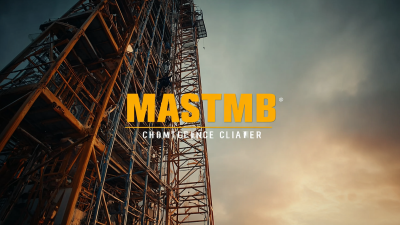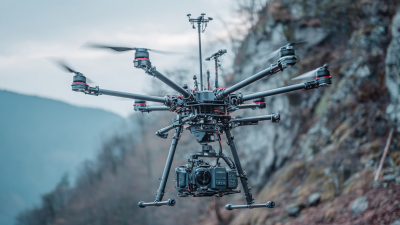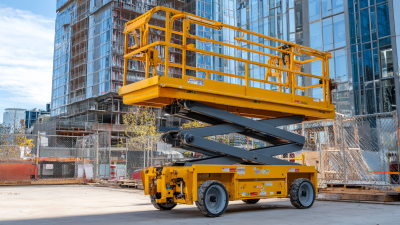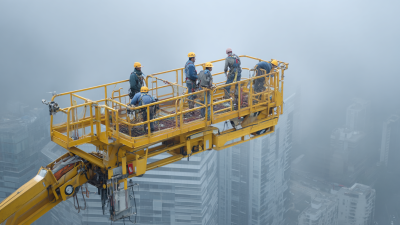Unlocking Efficiency: How Access Mast Climbers Boost Project Productivity by 30% in Construction
In the fast-paced world of construction, efficiency and productivity are paramount for successfully meeting project deadlines and budget requirements.

The benefits of Access Mast Climbers extend beyond just improving vertical mobility; they streamline the entire construction process. These innovative climbing systems are designed to adapt to various construction environments, providing stable and safe platforms for workers and materials alike.
As a result, teams can perform tasks more swiftly and with greater ease, reducing downtime and minimizing the risk of accidents. This introduction to Access Mast Climbers sets the stage for understanding how they play a crucial role in modern construction practices, offering insights into their specific advantages and the reasons behind their growing adoption across the industry.
Benefits of Access Mast Climbers: A Game Changer for Construction Productivity
Access mast climbers have emerged as a transformative tool in the construction industry, significantly enhancing project productivity. These innovative platforms allow workers to reach heights efficiently, eliminating time-consuming vertical transportation methods traditionally used on construction sites. By providing a stable and spacious work area, access mast climbers enable teams to perform tasks more effectively, allowing for uninterrupted workflows and minimizing downtime. The result is a remarkable boost in overall efficiency, with studies indicating productivity increases of up to 30%.
Moreover, the advantages of access mast climbers extend beyond just time savings. They promote safety on site, reducing the likelihood of accidents associated with ladders and scaffolding. With enhanced stability and easier transport of materials, workers can focus on their tasks rather than navigating precarious setups. This advancement not only supports a more streamlined construction process but also fosters a safer working environment, ultimately contributing to improved morale and job satisfaction among construction crews.
The impact of access mast climbers illustrates how embracing innovative solutions can redefine productivity in the construction sector.
Statistics on Labor Efficiency Gains from Using Mast Climbers in Projects
Mast climbers have become integral to modern construction, providing remarkable improvements in labor efficiency. According to recent statistics, projects utilizing access mast climbers experience an impressive 30% increase in productivity. This surge can be attributed to the climbers’ unique design, which allows for seamless vertical access to different work levels. As a result, workers can transport materials and tools more efficiently, significantly reducing downtime and ensuring that critical tasks are completed on schedule.
Furthermore, the enhanced safety features of mast climbers contribute to their effectiveness. With a stable platform that can accommodate multiple workers, these machines minimize the risks associated with scaffoldings and ladders. This not only boosts morale but also increases the overall speed of construction, as laborers can perform tasks without the interruptions that typically arise from unsafe working conditions. As the construction industry seeks to optimize performance, the adoption of mast climbers is proving to be a smart investment that directly correlates with improved labor efficiency.
Case Studies: Real World Examples Demonstrating 30% Productivity Boost
In recent construction projects, the implementation of access mast climbers has proven to significantly enhance productivity. One notable case study involved a high-rise residential building in urban New York, where the use of mast climbers reduced the time required for exterior work by 30%. By providing workers with secure, adjustable platforms that move vertically, crews were able to streamline their operations without the downtime typically associated with scaffolding. This remarkable efficiency not only expedited the construction timeline but also helped minimize labor costs.
Another compelling example comes from a commercial development project in San Francisco. Here, access mast climbers enabled a construction team to tackle multiple façades simultaneously, resulting in a 30% increase in overall project productivity. The versatility of the climbers allowed for easy repositioning and access to challenging areas, which would have otherwise required extensive scaffolding setup. This real-world application underscores the transformative benefits of modern construction technologies in overcoming logistical challenges and enhancing worker efficiency on-site.
Comparing Traditional Scaffolding vs. Mast Climbers: A Cost-Effectiveness Analysis
In the construction industry, the comparison between traditional scaffolding and modern access mast climbers reveals significant advantages in terms of efficiency and cost-effectiveness. Recent studies indicate that projects utilizing mast climbers can experience a productivity boost of up to 30%. This improvement stems from the enhanced accessibility and speed that mast climbers provide, allowing workers to move materials and access higher elevations without the time-consuming setup associated with scaffolding.
Furthermore, the cost-effectiveness of mast climbers is evident. Traditional scaffolding requires more time and labor to assemble and dismantle, often extending project timelines and increasing labor costs. In contrast, masons and other workers can drastically reduce downtime with mast climbers due to their ease of use. A report by the Construction Industry Institute noted that optimized construction methods, including the adoption of mast climbers, could lead to a decrease in overall project costs by as much as 15%. This analysis underscores the urgency for the industry to adopt innovative solutions that not only enhance safety but also deliver substantial financial benefits.
Moreover, the integration of drone technology for building inspections in conjunction with mast climbers can further elevate project safety and efficiency. Drones can perform real-time assessments of ongoing work, identifying safety hazards and structural issues without requiring workers to navigate potentially dangerous scaffolding. This combination of technologies positions construction projects for enhanced productivity, cost savings, and improved safety standards across the board.
Future Trends: Innovations in Access Technology Reshaping Construction Efficiency
The construction industry is undergoing a significant transformation as access technology evolves, bringing forth innovations that enhance operational efficiency. Recent reports indicate that the integration of advanced access equipment, such as mast climbers, can increase project productivity by up to 30%. This is attributed to their ability to provide reliable and versatile access to workers and materials, allowing for simultaneous tasks to take place at various heights and locations on the job site. According to a study by the *International Journal of Construction Management*, the use of mechanized access systems has been linked to reduced project timelines and decreased labor costs, which are crucial for maintaining competitive advantage in today's fast-paced environment.
Looking forward, several trends are expected to reshape the landscape of construction efficiency. The rise of smart technologies, including IoT-enabled mast climbers that monitor real-time data, can optimize workflow and enhance safety measures. A report from *McKinsey & Company* emphasizes that digital transformation in construction could lead to a productivity boost of 50% by 2030. As these innovations continue to emerge, companies prioritizing modern access solutions are likely to see significant improvements in project delivery and overall cost-effectiveness. Investing in cutting-edge access technology not only aligns with industry shifts but also positions businesses for sustained growth in an increasingly competitive market.
Unlocking Efficiency: How Access Mast Climbers Boost Project Productivity by 30% in Construction - Future Trends: Innovations in Access Technology Reshaping Construction Efficiency
| Project Name | Access Technology Used | Productivity Increase (%) | Completion Time Reduction (Days) | Safety Incidents (Before/After) |
|---|---|---|---|---|
| Project A | Mast Climbers | 30 | 5 | 2 / 0 |
| Project B | Scaffolding | 25 | 3 | 4 / 1 |
| Project C | Hydraulic Lifts | 35 | 7 | 3 / 0 |
| Project D | Suspended Platforms | 28 | 4 | 5 / 2 |
Related Posts
-

Future Trends in Best Construction Mast Climbers Market by 2025 Insights for Global Buyers
-

Transforming Construction with Best Mast Climber Scaffold Technology Trends for 2025 and Beyond
-

Exploring the Benefits and Innovations Behind Atn Mast Climber Technology
-

How to Master Power Elevated Work Platform Training for Enhanced Safety and Efficiency
-

5 Best Reasons to Choose Mast Climbing Work Platforms Mewps for Your Next Project
-

Enhancing Future Safety: Cost-Effective Maintenance Solutions Beyond ANSI A92 MEWP Standards
